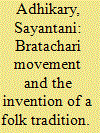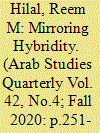| Srl | Item |
| 1 |
ID:
142835


|
|
|
|
|
| Summary/Abstract |
The Bratachari movement, officially inaugurated in 1934, was shaped by the bodily anxieties of educated middle-class Bengalis and aimed at the all-round development of the body, mind and soul through the invention of a specific tradition. Though the founder of the movement, Gurusaday Dutt, attempted to construct a ‘martial’ genealogy for the ‘effeminate’ Bengalis through adequately ‘masculine’, ‘indigenous’ folk dance forms, the ideology around which the movement was built was not entirely ‘indigenous’. Indeed, it seemed to borrow from the English agenda of the revival of folk traditions and the German idea of Volksgeist to a large extent.
|
|
|
|
|
|
|
|
|
|
|
|
|
|
|
|
| 2 |
ID:
178106


|
|
|
|
|
| Summary/Abstract |
This article explores the way in which Laila Halaby in Once in a Promised Land and Alia Yunis in The Night Counter utilize the Arab folk tradition in novels on Arab and Muslim American experience to counter the dominant narrative that simultaneously erases their extensive history in the United States and juxtaposes it with a forced visibility that is marked by Otherness, threat, and distrust. The article argues that by using folkloric figures and storytelling structures, Halaby and Yunis reverse the positionality of these communities by marking the multiple cultural signifiers that inform their stories in order to construct a palimpsest that reinscribes Arab and Muslim American experiences within narratives that perceive them as problems. As such, the Arab folk tradition emerges as a significant mode in the cultural memory of Arab and Muslim Americans, and the American literary fabric more broadly, and takes on a new meaning in this context.
|
|
|
|
|
|
|
|
|
|
|
|
|
|
|
|